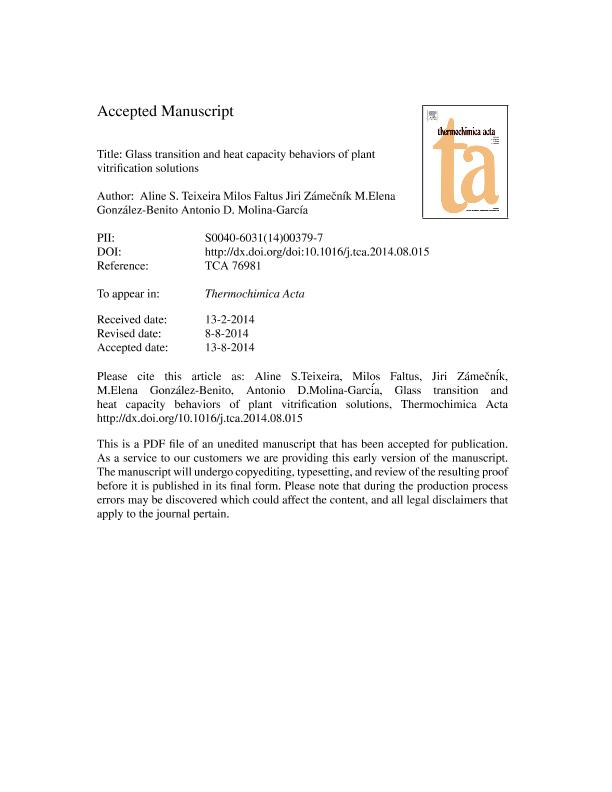Artículo
Glass transition and heat capacitybehaviors of plant vitrification solutions
Schneider Teixeira, Aline ; Faltus, Milos; Zámečníkc, JirI; Gonzalez Benito, Maria Elena ; Molina García, Antonio D.
; Faltus, Milos; Zámečníkc, JirI; Gonzalez Benito, Maria Elena ; Molina García, Antonio D.
 ; Faltus, Milos; Zámečníkc, JirI; Gonzalez Benito, Maria Elena ; Molina García, Antonio D.
; Faltus, Milos; Zámečníkc, JirI; Gonzalez Benito, Maria Elena ; Molina García, Antonio D.
Fecha de publicación:
10/2014
Editorial:
Elsevier Science
Revista:
Thermochimica Acta
ISSN:
0040-6031
Idioma:
Inglés
Tipo de recurso:
Artículo publicado
Clasificación temática:
Resumen
Differential scanning calorimetry (DSC) was employed to investigate the vitrification and annealing behaviors of the most commonly used plant vitrification solutions (PVS). These solutions are employed to protect plant tissues towards ice formation and freeze injury, and help to the vitrification of these tissues, by globally reducing the intracellular fluids mobility. Glass transition temperatures (Tg) and heat capacity increments (∆Cp) were determined for five solutions PVS1, PVS2, PVS2 mod, PVS3 and PVS3 mod, with different composition, and a range of cooling and warming rates was employed. Glass transitions showed clear and consistent temperature differences within vitrification solutions, which could be related to composition and water content. Roughly, two sets of TG values were obtained, those for PVS1 and 2, at -112 ºC and -114 ºC, respectively, and those for PSV3, at -90 ºC. The observed Tg and ∆Cp, unexpectedly, did not significantly change within a wide range of cooling rates (from 5 ºC min-1 to liquid nitrogen quenching) and warming rates (from 5 to 20 ºC). Garlic shoot tips cryopreserved after the droplet method produced a similar result to that of the vitrification solutions employed. After quench cooling to temperatures below Tg, repeated excursions to higher temperatures were made and the cooling and warming Tg were recorded. These treatments had little or no effect over the PVS solutions Tg, which remained practically constant. A direct practical consequence is that the plant vitrification solutions glass transition temperature does not significantly change with cryopreservation methods based on either direct plunging of samples into liquid nitrogen or employing closed cryovials.
Palabras clave:
Dsc
,
Plant Vitrification Solution
,
Tg
,
∆Cp
,
Cryopreservation
Archivos asociados
Licencia
Identificadores
Colecciones
Articulos(CIDCA)
Articulos de CENTRO DE INV EN CRIOTECNOLOGIA DE ALIMENTOS (I)
Articulos de CENTRO DE INV EN CRIOTECNOLOGIA DE ALIMENTOS (I)
Citación
Schneider Teixeira, Aline; Faltus, Milos; Zámečníkc, JirI; Gonzalez Benito, Maria Elena ; Molina García, Antonio D. ; Glass transition and heat capacitybehaviors of plant vitrification solutions; Elsevier Science; Thermochimica Acta; 593; 10-2014; 43–49
Compartir
Altmétricas



